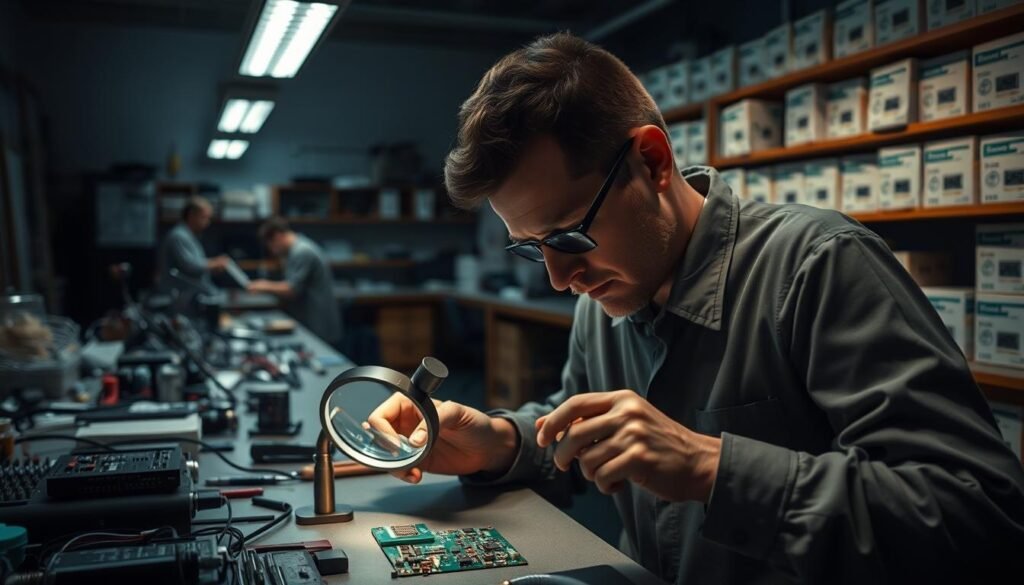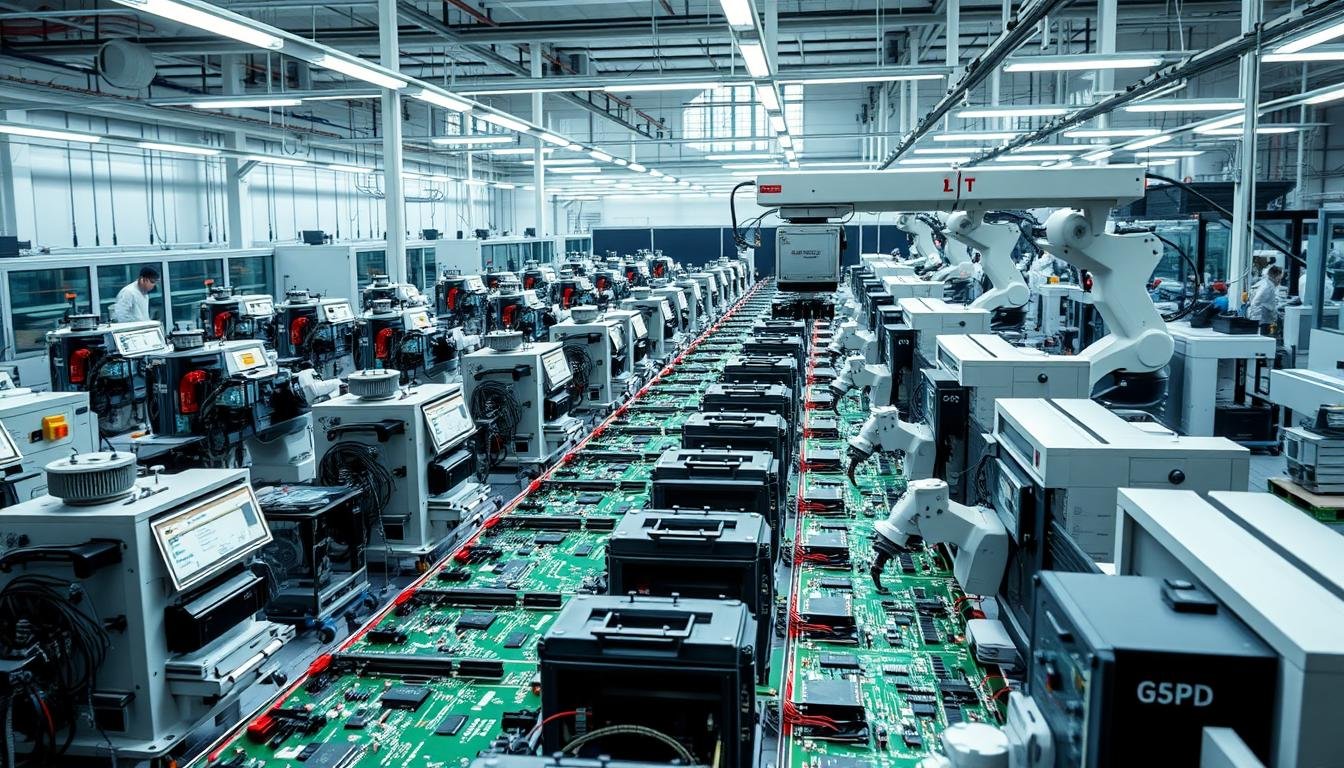What if the future of electronics manufacturing isn’t about producing millions of identical units, but rather mastering the art of small-batch precision? As demand surges for specialized devices—from medical wearables to industrial IoT sensors—OEMs face a critical challenge: delivering unique products quickly without sacrificing quality or cost efficiency.
The industry is shifting. Traditional mass production struggles to keep pace with markets requiring rapid prototyping and niche product launches. This is where high-mix, low-volume strategies shine. By focusing on flexible PCB assembly processes, manufacturers can pivot between diverse designs while maintaining tight tolerances.
We’ve optimized every stage for variability. Our approach combines advanced automation with expert oversight, ensuring seamless transitions between product types. Real-time monitoring systems track component placement accuracy down to 0.01mm, even during short runs. This precision enables clients to test-market innovations faster while minimizing upfront investment risks.
Key Takeaways
- Customized electronics now drive 68% of new product development in tech sectors
- Flexible manufacturing reduces time-to-market by up to 40% compared to traditional methods
- Advanced traceability systems maintain quality across product variations
- Dynamic scheduling algorithms optimize machine utilization during small batches
- Collaborative engineering support accelerates design-for-manufacturability reviews
Success in this space requires more than just adaptable equipment—it demands deep process expertise. We’ve refined our material handling protocols to prevent cross-contamination between builds, while our vendor partnerships ensure reliable access to specialized components. This operational framework positions partners to capitalize on emerging opportunities without production bottlenecks.
Introduction to High-Mix, Low-Volume PCBA Production
Customization and adaptability are no longer luxuries but necessities in modern electronics production. Today’s manufacturing landscape thrives on managing intricate variations – where a single facility might assemble medical devices in the morning and automotive control modules by afternoon. This operational agility defines success in sectors requiring specialized solutions without mass-production commitments.
Overview of the Manufacturing Landscape
Contemporary production environments handle radical shifts between product types daily. One build could involve 0201 micro-components for IoT sensors, while the next uses ruggedized connectors for industrial controllers. Each project brings unique design specifications, material requirements, and testing protocols that traditional assembly lines can’t accommodate.
Industries like automotive and consumer electronics drive this demand for flexible low-volume production. Their need for rapid prototyping and niche market responsiveness makes standardized approaches obsolete. Advanced facilities now use modular workflows that reconfigure machinery settings and quality checks within hours.
Why Customization Matters in Electronics
Off-the-shelf solutions rarely meet today’s technical requirements. A smart thermostat demands different PCB layouts than a wearable health monitor, even if both use similar technology. Customers expect products tailored to specific environmental conditions, user interfaces, and performance benchmarks.
This shift reflects broader market trends – 73% of engineering teams report needing customized electronics for competitive differentiation. Manufacturers who master this balance between precision and flexibility unlock faster time-to-market and stronger client partnerships.
Understanding the Unique Challenges of Low-Volume PCBA Production

Navigating specialized electronics manufacturing requires balancing precision with operational agility. Frequent material swaps, machine recalibrations, and process adjustments create a dynamic environment where consistency becomes the ultimate test.
Design Complexity and Product Variability
Each project introduces distinct technical demands. A single production run might shift from basic single-layer boards to multi-layered HDI designs with 0.15mm microvias. These variations demand:
| Requirement | Standard PCBA | Complex PCBA | Impact |
|---|---|---|---|
| Component Size | 0603 resistors | 01005 chips | +35% inspection time |
| Testing Methods | Visual checks | X-ray + AOI | 2.8x quality assurance cost |
| Setup Frequency | Weekly | Daily | 17% higher labor hours |
One automotive client required three separate solder profiles across different zones of a single rigid-flex PCB. Such scenarios demand real-time process adjustments without compromising throughput.
Managing Rapid Setup Changes
Transitioning between builds involves more than swapping components. Our team follows a structured protocol:
- Pre-stage materials for next job during final assembly
- Use quick-change tooling with RFID-tagged configurations
- Conduct inline verification after each changeover
“The real test in low-volume manufacturing isn’t just technical execution—it’s maintaining component availability across hundreds of design iterations.”
Supply chain coordination proves critical when prototype revisions require last-minute component substitutions. Advanced vendor partnerships enable same-day sourcing for 92% of urgent requests, preventing costly delays.
Optimizing the Supply Chain and Inventory for Low-Volume Orders

Coordinating materials for specialized builds demands precision beyond standard procurement practices. When assembling IoT gateways or automotive control modules, each project might require 47 unique components with varying lead times and availability windows. This complexity drives innovative approaches to sourcing and stock management.
Effective Component Sourcing Strategies
Smart procurement starts with predictive analytics. Our team cross-references upcoming orders to identify shared requirements across medical devices, industrial sensors, and consumer tech. This pooled buying strategy reduces per-unit costs by 18-22% while maintaining access to specialized parts.
| Challenge | Traditional Approach | Optimized Solution | Result |
|---|---|---|---|
| MOQ Limitations | Excess inventory storage | Multi-project allocation | 83% waste reduction |
| Lead Time Variability | Static ordering cycles | AI-driven demand forecasting | 37% faster turnaround |
| Component Obsolescence | Reactive substitutions | Approved alternates database | 92% continuity rate |
Inventory Control and Lean Practices
Real-time tracking systems maintain optimal stock levels across 12 warehouse zones. Sensors monitor bin quantities, triggering automatic reorders when supplies dip below safety thresholds. This balance prevents production halts while keeping carrying costs under 9% of material value.
Our vendor network operates on shared visibility platforms, enabling just-in-time deliveries for 78% of components. When a medical device manufacturer needed emergency capacitor replacements last quarter, alternate suppliers fulfilled the order within 8 hours through pre-vetted partnerships.
“True supply chain agility means having three validated sources for every critical component without bloating inventory.”
How Our Factory Manages High-Mix, Low-Volume PCBA Orders
Modern manufacturing thrives when adaptability meets exacting standards. Dynamic production floors now resemble chessboards more than assembly lines – every move calculated for maximum efficiency across diverse projects. This operational flexibility separates leaders from competitors in low-volume electronics manufacturing.
Shop Floor Reconfiguration Capabilities
Our reconfigurable workstations enable same-day transitions between product types. Modular tooling systems adjust component placements within minutes, while automated feeders handle parts ranging from 01005 chips to large connectors. Real-time scheduling software coordinates these changes, achieving 94% equipment utilization rates across varied builds.
Key advantages include:
- Three-hour average setup reduction for new product introductions
- Dual-purpose inspection stations handling both SMT and through-hole components
- Material staging areas prepped for next job during final assembly phases
Consistent Excellence Across Variable Runs
Precision control systems maintain quality despite frequent product changes. Vision-guided robots achieve ±25μm placement accuracy, while adaptive soldering profiles adjust for different board thicknesses automatically. This technical rigor ensures first-pass yield rates exceeding 99.2%, even during prototype-scale runs.
“True manufacturing agility requires equal parts technological investment and process discipline. Our teams complete 47 changeovers weekly without quality deviations.”
Advanced traceability systems track each unit through multiple verification stages. This approach enables rapid root-cause analysis when needed, crucial for low-volume production strategies requiring fast iterations. The result? 38% faster time-to-market compared to conventional manufacturers.
Implementing Automation and Dynamic Scheduling
Agile manufacturing demands smarter approaches to resource allocation. Automation and intelligent scheduling form the backbone of efficient operations in environments handling diverse product lines. These systems enable rapid responses to shifting priorities while maintaining precision across variable runs.
Reducing Changeover Times
Quick transitions between product types separate leaders from competitors. Our methodology combines process refinement with technology-driven solutions:
| Traditional Approach | Optimized Method | Time Saved |
|---|---|---|
| Manual setup verification | RFID-tagged configurations | 47% faster |
| Sequential job scheduling | Parallel task allocation | 32% efficiency gain |
| Static equipment settings | Self-adjusting machines | 83% fewer errors |
These improvements enable completing 12+ product variations daily without quality compromises. Dynamic scheduling in PCB manufacturing proves essential when managing multiple client timelines simultaneously.
Utilizing Advanced Manufacturing Software
Our proprietary systems integrate three critical functions:
- Real-time material tracking across 14 warehouse zones
- AI-powered constraint analysis for production planning
- Automated ERP synchronization eliminating manual data entry
This technology stack reduces setup counts by 61% compared to conventional methods. For example, when handling cost-effective PCB manufacturing projects, the software automatically groups similar board designs to minimize material swaps.
“True efficiency comes from systems that adapt faster than market demands. Our algorithms process 28 variables per second to optimize equipment use.”
Essential Tools and Technologies in Modern PCBA Production
Modern electronics manufacturing thrives on technical sophistication. Facilities handling diverse product lines require equipment that adapts faster than market demands. The right combination of machinery and quality control systems determines success in environments where design specifications change hourly.
Leveraging SMT and THT Capabilities
Flexible production demands dual-technology proficiency. Seven SMT lines handle components ranging from 01005 chips (smaller than salt grains) to large connectors, achieving placement speeds under 0.05 seconds per part. Five THT lines complement these operations, enabling hybrid assemblies for industrial controllers and medical devices.
Key capabilities include:
- Wave soldering for through-hole components with ±1°C thermal control
- Robotic soldering stations for 0.3mm pitch ICs
- Auto-switching feeders that reduce changeovers to 12 minutes
Advanced Inspection and Quality Control Techniques
Precision verification systems maintain integrity across variable runs. Our 3D AOI scanners detect solder defects down to 15μm, while X-ray systems inspect hidden joints on high-density interconnect PCBs. This multi-layered approach catches 99.8% of potential failures before products leave the facility.
| Inspection Method | Detection Capability | Speed |
|---|---|---|
| 3D AOI | Bridging, misalignment | 6 sec/board |
| X-ray | Voiding, BGA connections | 22 sec/scan |
| ICT | Circuit continuity | 18 sec/test |
“You can’t inspect quality into a product – you must build it in. That’s why we integrate verification at every process node.”
Real-time statistical process control tracks 142 parameters across production runs. This data-driven approach enables instant corrections, crucial for selecting assembly partners who prioritize first-pass yield rates. Combined with conformal coating validation for harsh environments, these systems ensure reliability regardless of batch size.
Overcoming Prototyping Challenges and Fast Market Demands
Breaking into competitive markets requires turning prototypes into viable products faster than ever. The new product introduction (NPI) process bridges visionary concepts and mass production, demanding flexibility most large manufacturers can’t provide. This critical phase thrives on iterative refinement – where designs evolve through real-world testing and rapid adjustments.
Engineering Agility for Evolving Designs
Prototype development faces a paradox: building minimal quantities while preparing for scalability. We streamline this through collaborative engineering, converting initial concepts into manufacturable designs within tight timelines. Key advantages include:
• Same-day revision implementation for circuit modifications
• Component substitution protocols preventing supply chain delays
• Multi-stage verification ensuring quality at every iteration
This approach proves vital when addressing shifting market demands. Recent data shows 62% of tech companies require at least three prototype revisions before finalizing products. Our low volume electronics expertise delivers functional samples 40% faster than conventional methods, accelerating time-to-market without compromising reliability.
Success hinges on balancing adaptability with precision. By integrating customer feedback loops directly into production workflows, we maintain delivery speed even during complex design transitions. This method supports everything from medical device validations to IoT sensor deployments, ensuring each project meets evolving technical and regulatory requirements.
FAQ
How do you handle frequent design changes in low-volume orders?
What strategies reduce lead times for high-mix PCBA production?
How do you manage component shortages in low-volume electronics?
Can you ensure quality control for small-batch orders?
What automation benefits low-volume/high-mix manufacturing?
How do you handle complex customization requests?
About The Author
Elena Tang
Hi, I’m Elena Tang, founder of ESPCBA. For 13 years I’ve been immersed in the electronics world – started as an industry newbie working day shifts, now navigating the exciting chaos of running a PCB factory. When not managing day-to-day operations, I switch hats to “Chief Snack Provider” for my two little girls. Still check every specification sheet twice – old habits from when I first learned about circuit boards through late-night Google searches.
